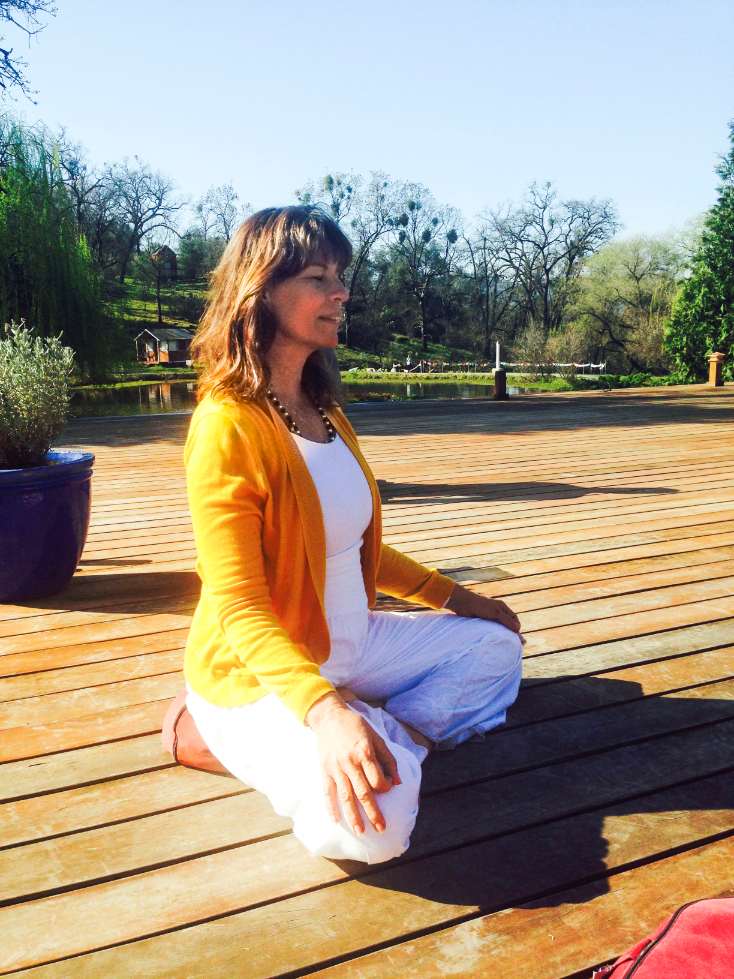MIND
What is the mind? | How does the mind work? | Am I my mind?
The contents on these Our Teachings webpages are reproduced from the book “Essentials of Yoga Practice and Philosophy” compiled by Swami Sitaramananda.
Below is a testimonial for this book.
A concise guide to Yoga in all of its aspects, healing, mantra, pranayama, asana and meditation as taught by one of the most important Yoga lineages of the modern world, Essentials of Yoga Practice and Philosophy is a helpful resource that all serious Yoga students should keep close by for regular study.
On this page you can read about:
What is the Mind?
The mind is in the astral body, and is subtle and powerful.
It is our instrument of perception.
Like a pair of glasses which you use to see through, the defects or tint of the glasses will make you perceive defects outside and will color what you see.
In “Bliss Divine” Swami Sivananda says about the mind, “The activity of the mind is the cause of all appearances. So long as there is the mind, there are all these distinctions of big and small, high and low, inferior and superior, good and bad, etc…”
Quote: “Conquest of mind is very hard indeed; but not impossible. Therefore try and try, again and again, you will succeed at last.” – Swami Sivananda in “Elixir Divine”
The thinker is different from thought. Mind is as much your property and outside of you as your limbs, the dress you wear and the building you dwell in.”
Sitting with the body still and upright one begins to watch the mind and thoughts.

When one looks within and tries to become aware of the thoughts one starts to understand the mind.
Why do we need to control our mind?
What we perceive externally is in fact a reflection of the quality and conditioning of our mind. If we are angry then we will find a reason to be angry about anything. If we are depressed, everything looks depressing, and so on. The whole world is in our mind. We have the feeling that the world is a big place and we have no control over it. We feel victimized by a lot of things. Yoga helps us to regain clarity and power by helping us to control our mind. The process of going inward to find answers means finding out the conditioning of our mindset and adjusting it to reality, thus bringing us to a true vision of ourselves and of reality, and freeing us from seeing distortions or illusions.Mind and Emotions
To be able to control the mind, we have to be detached from it and know that the mind is not us, but only our instrument. In the same manner, a cloud covering the sun may make us think that the sun is not there, but if we know that the sun is always there, then we can feel and see that the black and cold is just a temporary state. The mind can go through different states but you can make it change if you do not believe in what you see or feel as being yourself. You stay detached, and you know that the mind is not you. Instead of saying, “I am angry”, you say, “There is anger in my mind.” Instead of saying, “I hate this person”, you say, “There is hatred in my mind.” Yoga, by slowing down the body and mind, help you cultivate this process of detachment.How the mind works
Now, we will give you a few analogies in order to help you to understand the science of the mind and to recognize your own mind. We are not aware of the functioning of the mind and become victim to it. Learning how the mind works is like learning how to drive a car, so that we are able to guide the mind instead of the mind creating havoc without our control.
Mind is compared to a lake which when calm is without disturbing though waves.

Spending time in nature calms the mind.
Science of the Mind
- Mind is like a lake; it constantly has thought waves. Swami Sivananda says that the mind havocs through the power of fluctuation. That I why the meditator endeavors to calm the thought waves down by concentration. A clear lake without waves is capable of giving you a true reflection of yourself (sattvic mind); a wavy lake distorts the reflection (rajasic mind); a muddy lake will not allow you to see clearly (tamasic mind).
- Mind is like a drunken monkey; it is very restless and jumpy. Swami Sivananda says that the mind has wandering habits. It wants variety. Thoughts are disorderly and random, without much continuity or focus. Know this and learn to keep the mind more focused.
- Mind is like a wild horse; it does not like to be tamed but likes to go its own way. Like a spoiled kid or a badly trained animal, the mind does not like to be trained and follows its own will, resisting all attempts to control it. Thus, one has to be gentle with the mind and slowly gain its trust to guide it in the right direction.
- Mind is like a shy lady; it likes to hide and not be seen. It is difficult to reveal the secrets of the mind, as it will not cooperate easily. However, when one is able to see it for what it is, the turbulent mind calms itself down.
- Mind is like a music record; it has grooves and habits. Everyone’s mind is conditioned specifically by previous experiences and habits. Sometimes, the record is scratched and bad tunes are played – as in the case of our repeated bad patterns – we need help sometimes to lift the needle and change the groove to a more positive habit.
- Mind is like a fast-spinning fan; it can move very fast and you cannot distinguish the thoughts, but the thoughts can harm you. This is why, in Yoga, we learn to slow down the thought waves through asanas, pranayama and self observation in order to switch the patterns of thought. This analogy also shows that the concentrated mind is very powerful; a concentrated person may appear to be doing nothing, and yet his mind is extremely active.
- Mind is related to body; that is why if you straighten your posture (asana), you straighten your mind. Asana practice is the best way to begin controlling the mind.
- Mind is related to the breath; that is why if you calm down your breath and control the prana (pranayama), you control the mind. The breath is like the wind that creates the waves on the lake; it is difficult to control the waves, but if there is no wind, there are no waves.
- Mind is related to the senses; controlling the senses will calm down the mind and controlling the mind can reduce the effect of the sensory stimulation that would agitate the mind. If the mind is kept focused, the senses will not operate, as the senses can not operate without the cooperation of the mind. The idea is that we are not victims to sensual influences and that we have ways to escape the allurements of the senses.
- Mind, although fast, can only think of one thought at a time;if you feel stressed out, simply do one thing at a time. This is an important idea as it helps us to understand what concentration is, and why we need to concentrate on a positive thought, like a mantra, in order to reduce stress and worry.
- Mind functions with names and forms; the mind itself is limited as it only functions along with words and images. This is why we use words or images to focus on; we understand that words and images are the limited way to express the reality that is beyond the grasp of the mind. This world as we know it is just the world of names and forms, and there is another reality beyond it. That reality can be experienced only when we go beyond the mind.
- The mind functions by association. We can use this associative tendency of the mind to eliminate unhelpful thoughts and accentuate helpful thoughts.
Transcending the Mind
It includes working with the three levels of our mind, the subconscious, the conscious and the super-conscious. Yogis want to clear the subconscious (instincts and emotions), fully utilize the conscious (intellect) and develop the super-conscious (intuition). You can understand how the mind works through yoga and meditation practice.Yoga Teacher Training Course
Check out our 200-hour Yoga Alliance certified Yoga Teacher Training Courses offered twice a year in California, 3x in Vietnam, once in China and once in Japan.
Foundational Courses
Choose from upcoming courses for beginners and intermediate level students.
Yoga Vacation
Rejuvinate your body and mind. Experience and progress with daily Yoga classes. Learn the 12 basic asanas and pranayama. Enjoy daily meditation, chanting, and organic vegetarian meals.
Check out our Blog
Our Sivananda Yoga Farm Blog has numerous articles, videos, and talks given by our senior teachers over the years.
OUR TEACHINGS
Satsang
What is Satsang? What is Meditation? What is Kirtan Chanting?
5 Points of Yoga
Exercise, Breathing, Relaxation, Diet, Positive thinking and Meditation
Health
What is True Health? What is health of body, mind, and spirit?
Prana
What is Prana? How can I access prana? What is kundalini energy?
Raja Yoga
What is Raja Yoga? What are the eight limbs? What is ashtanga yoga?
Jnana Yoga
Who am I? What is Vedanta Philosophy? What is Sat-Chit-Ananda?
Mantras
What is a mantra? What is sanskrit? How do I get a mantra?
Yoga Poses
How do the asanas work? What are the benefits? What are some guidelines?
Yoga
What is Yoga? Where did Yoga come from? What is Classical Yoga?
Life
What is the meaning of Life? What is Freedom? What is Happiness?
Mind
What is the mind? How does the mind work? Am I my mind?
Positive Thinking
What is thought? What are techniques to practice positive thinking?
Karma Yoga
What is Karma? What is Karma Yoga? How to practice karma yoga?
Bhakti Yoga
What is True Love? Who is God? What is an inner Bhava?
Kirtan Chanting
What is Kirtan Chanting? How does it work? What do the chants mean?
Ayurveda
What is ayurveda? What are the 3 doshas? What is disease according to ayurveda?